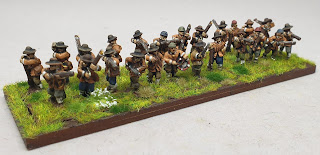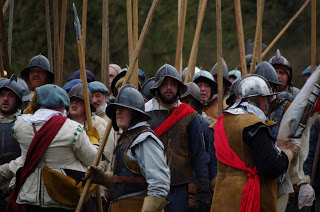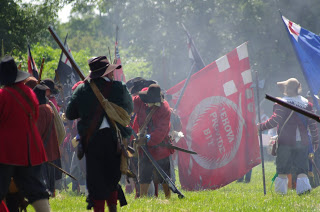Lieutenant General Thomas Hammond's Regiment of Firelocks
This Lieutenant General Thomas Hammond must not be confused with Lieutenant General George Hammond, commander of Stargate Command. Hammond's firelocks were the artillery guard of the Eastern Association, not a galaxy traveling special forces unit that was part of Stargate Command.
They are described as wearing tawny coloured coats pre NMA, then tawny orange coloured coats lined with white when they were the firelock guard of the NMA. Hammond was paid for two colours in April 1645, but we don't know what they looked like - which is just as well as my firelocks/commanded shot don't carry colours.
Believed to have been raised at the same time as the artillery train of the Eastern Association, they were most likely present wherever the Eastern Association fought: more specifically they were possibly present at Lincoln, and were certainly at the Siege of York and Marston Moor before continuing the fight at Second Newbury. In 1645 they joined the New Model Army as the Artillery Guard of Firelocks. In their new guise they fought at Oxford, Naseby, Leicester and Bristol.
They are described as wearing tawny coloured coats pre NMA, then tawny orange coloured coats lined with white when they were the firelock guard of the NMA. Hammond was paid for two colours in April 1645, but we don't know what they looked like - which is just as well as my firelocks/commanded shot don't carry colours.
Thomas's nephew, Lieutenant-Colonel Robert (Robin) Hammond, was Charles I's gaoler in the Isle of Wight during 1647–8.
Nothing much is known about Thomas Hammond's career until the Civil War, but he must have seen military service on the continent, since he was a trained gunnery officer before 1642. In 1644, as Lieutenant-General of the Ordnance in the Army of the Eastern Association, he testified against his own commander-in-chief the Earl of Manchester, in the celebrated clash with Lieutenant-General of Horse, Oliver Cromwell. No surprise that Hammond was appointed to the corresponding post in the New Model Army from the spring of 1645.
Named to the High Court of Justice in January 1649, he attended no fewer than fourteen of its sittings, including the occasion on which judgment was given against the king; he did not, however, sign the death warrant (it is claimed that he refused to sign it, but there is no corroborative evidence for this statement), and upon the Restoration he was clearly regarded, albeit posthumously, as having been a regicide.
He took part in the pre-emptive invasion of Scotland in 1650 where he became ill, never fully recovering, dying in 1658.
Quite a few headswaps in this unit, plus a few figures from the musketeers marching pack. There's also a dragoon on foot because I messed up a headswap and couldn't find another musketeer in the spares box. I used Foundry orange 3B for the coats and wasn't totally convinced I'd made the right choice until they were finished, not quite the effect I was after but quite pleased with how they have turned out (I had originally wanted a golden yellowy orange almost the colour of a lion).
If you enjoyed reading this, or any of the other posts, please consider supporting the blog.
Thanks.







.jfif)





Splendid looking firelocks,a nice convincing orange colour, difficult to get right, but I think you're spot on!
ReplyDeleteBest Iain
Thanks. Quite pleased with the colour in the end, even though it wasn't quite what I had intended
Delete